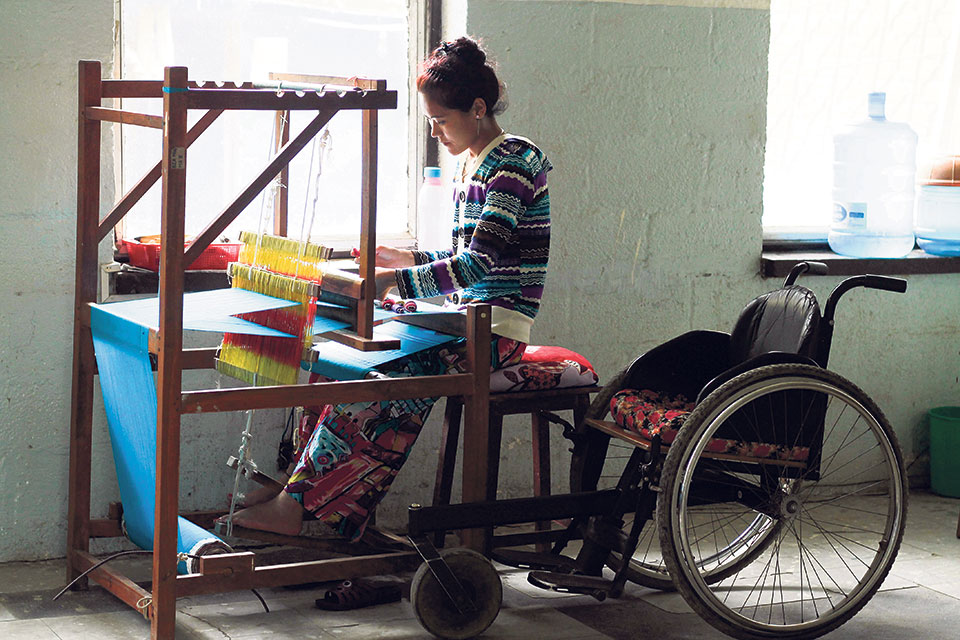Cham: The Dance Meditation (With Video)
5 years ago

5 years ago

5 years ago

5 years ago

5 years ago

5 years ago

When 35-year-old Ngawang Chhiri Sherpa was informed that he could not walk anymore, he was not downhearted with despair to what life threw at him. He rather summoned up the courage to find a way of living. It was after a year of his accident that his journey altered from that of trekking guide to a thanka artist.
“I have been teaching to paint thanka to the members at the BIA (Bodhisattvas in Action) Foundation for the past 12 years now, and I am elated by this feeling that I have been contributing from my side to uplifting the lives of people living with disability,” said Sherpa who is also the secretary at the BIA Foundation, Jorpati.
“Upon its inception in 2014, we had very few staffs engaged with us. However, with the extended number of staffs, we have introduced 12 projects that aim at uniting and empowering people with disability to make them economically, socially and emotionally independent,” added Sherpa.
Among those who deal their situation with great fortitude, there were a few who were left anguished by their disability for quite some time until they started to regain the vigor to live a contented life. 31-year-old Super Rai was hit hard by his spinal injury which barred him from moving his legs normally. After being bedridden for eight years in his hometown in Khotang, he was taken to Spinal Injury Rehabilitation Center, Sanga, then to Tatopani, Sindhupalchowk. There, he learned thanka art for three years.
“I started gaining confidence and realizing my concealed strength after I engaged myself in art and painting. As I started giving back to the community and earning for myself, it freed me with the guilt that had long remained within me,” he added.
Having received a prosthetic foot, 22-year Parbati Khatri is more inspired to walk. Originally from Dang, she burnt her toes while an infant and later lost her foot due to infection. Upon moving to Kathmandu with her husband, she started seeking for work opportunities to earn her living. While looking for work, she came across and joined BIA.
She works there as a seamstress, for the past three years. Additionally, she’s also a master incense maker. “Back home, I used to feel disheartened seeing my family members plowing the field and planting rice. But when I moved to Kathmandu, I started focusing on what I could actually do rather than on things I had difficulty doing. That emerging sense of feeling was immensely satisfying. I get motivated by my husband. He is visually impaired but preparing for his government service examination,” shared Khatri.
Damauli’s Purnima Darai felt a similar sense of contentment while she was at home. She had a different outlook on life after she started earning by making fancy bead necklaces and bracelets. “I worked as a bamboo carver for four months but I switched to making bead bracelets and necklaces. All the colorful beads come from various parts of Nepal,” Darai stated, and further briefing about the work process, she added, “The beads of bodhichitta, rudraksha, and bayar are difficult to pierce, but I enjoy taking up challenges.”
As stated by the motivational speaker with disability Nick Vijucic, “Fear is the biggest disability of all and will paralyze you more than you being in a wheelchair.”The underlying meaning of the phrase assimilates an exemplary scenario on how these people with disability have been leading a progressive living vanquishing their insecurities, barriers, and limitations. Furthermore, the social model of disability coined by an academician with disability Mike Oliver defines that disability is caused by the way society is organized, rather than by the person’s impairment or difference. It looks at ways of removing barriers that restrict life choices for disabled people.
The responsibility of empowering people with disabilities falls into the hands of both the individual and society. “The allowances provided by the government can hardly serve as a long-term tool for empowerment, thus, providing them with an open space, engaging them to work on their creativity and extracurricular activities for a long time can work as a therapy to bolster their mental strength,” says Gokarna Dhungana, Managing Director at BIA.
However, the scenario of people with disability in most parts of Nepal is not as friendly. They have been struggling with barriers in public and private sectors. “Here we encourage them to indulge in extracurricular activities including swimming, basketball, meditation, and marathon that help break the monotony of their daily work. The art therapy section also provides doodling and art classes to the young patients with Down’s syndrome and Cerebral Palsy.” So far, we have held basketball tournaments and competitions in Okhaldhunga, Kalikot, Pokhara, and Jumla. And we are looking forward to participating in a basketball competition in Mugu this December,” confirmed Dhungana.





Leave A Comment